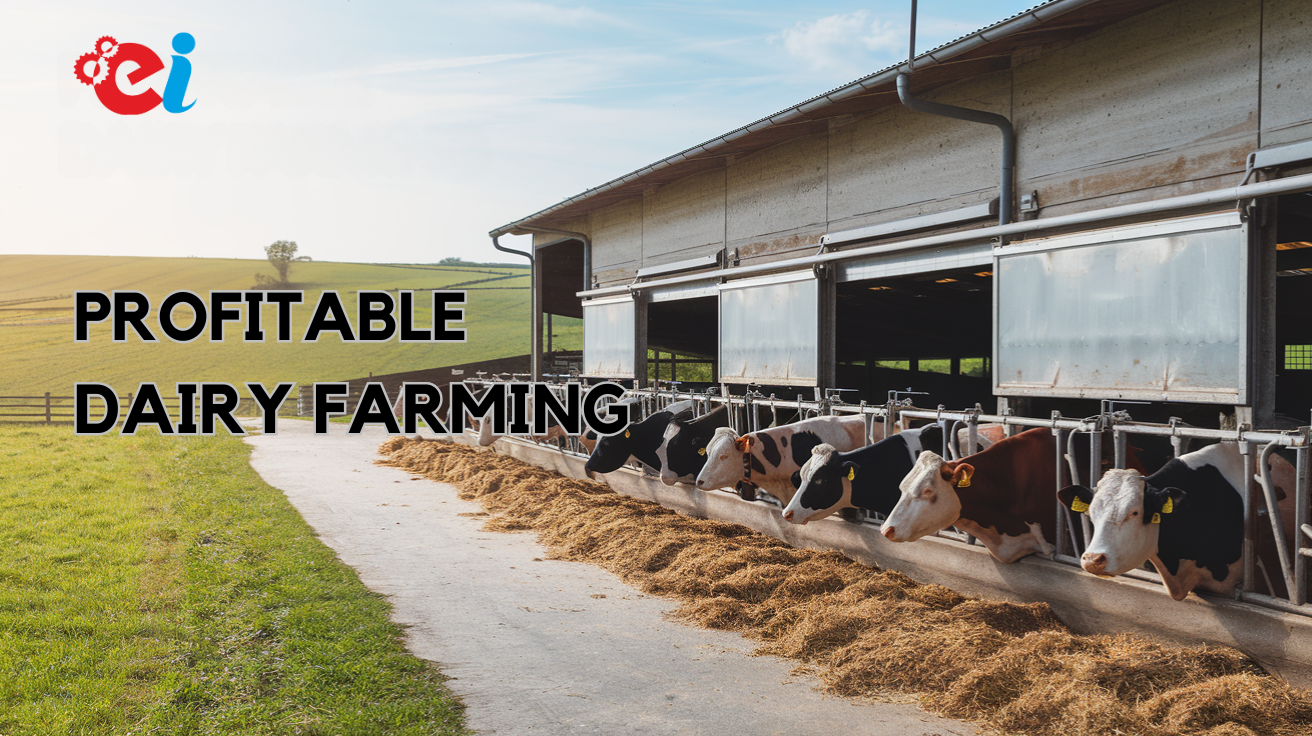The establishment of a dairy farming business proves to be a fantastic business venture. The milk and dairy products industry requires people to keep livestock cows for production. A dairy production business demands capital investments for building facilities along with cattle acquisition and implementation of required tools. Because of steady demand for dairy products, this business operates as a dependable enterprise.
Correct planning strategies enable dairy farming establishments to achieve profitability. The dairy business achieves continuous growth in each passing year. Customers regularly demand milk, along with butter and yogurt products from the market. The following piece examines what factors explain dairy farming profitability. The research provides an evaluation of both market expansion patterns and necessary business success elements.
Understanding Dairy Farming
The practice of dairy farming dedicates itself to raising livestock groups to produce milk. The milk production method extends to create various dairy products. Dairy farmers need to prioritize three main areas, which are cattle health and nutrition, along with breeding programs. Regular milk extraction from cattle produces products through processing. The production sequence yields cheese alongside butter together with yogurt and milk powder. Businesses involved in dairy farming must possess suitable facilities along with necessary tools. Well-kept cattle whose management is maintained properly provide greater milk production results.
Market Demand and Growth Potential
The dairy farming industry shows rapid growth at present. The milk production in India stands as the highest globally. The pace of milk production expansion has begun to decrease. The compound annual growth rate (CAGR) of milk production decreased to 3.78% during FY2024 from the previous value of 6.62%. The slower pace of dairy industry development does not reduce the escalating market demand for dairy products.
The dairy industry worldwide shows strong expectations of substantial market expansion. Marketers predict the dairy market value to grow from its current $124.93 billion in 2023 until it reaches $227.53 billion by 2030. Advantageous conditions open up for dairy farmers throughout this industry expansion. The marketplace requires rising quantities of both healthy and organic dairy products.
Related Project: Dairy Farming
Key Drivers of Market Growth
1. Health and Wellness Trends
Current health trends are responsible for driving dairy product consumption patterns. Dairy products contain both calcium with vitamins and protein as essential nutrients. Customers who emphasize health and wellness require dairy products to complete their dietary needs. The evolving dairy market gives openings to milk-producing enterprises that present customers with dairy options that are low in fat and organic and contain probiotics. Patients are selecting alternative milk options that are both nutritious and thus driving market expansion.
2. Expansion of the Food and Beverage Industry
There exists a rapid expansion of food and beverage businesses throughout the market. Dairy products serve as primary ingredients that the industry uses often. The production of ice cream alongside snacks along with sweets depends on dairy ingredients as fundamental materials. The growth of this market sector drives up the market need for milk products and their processed derivatives. Dairy organizations working with food and beverage producers will gain advantages from this market expansion.
3. Government Initiatives and Support
The Indian government supports dairy farming through various schemes. These programs offer monetary help combined with programs for dairy farmers and provide discounted support. A prime government program that supports milk development is the dairy development scheme. A financial support program exists through this scheme to help establish new dairy businesses. The support from government institutions helps decrease the start-up expenses of new farming operations. The existing support system established by government initiatives maintains an environment that enables successful growth of dairy business operations.
Also Know About : A Complete Guide to Start Dairy Farming Business in India
Profitability of Dairy Farming Business
Operation of a dairy farm establishes the potential for substantial profit. The dairy farming business generates appealing profits because of multiple economic components.
1. Steady Demand from Multiple Sectors
The need for milk together with dairy products remains constant throughout the day. People buy dairy products both inside their homes and commercial establishments every day. A steady market for dairy farmers exists because of constant customer demand. Stable market conditions coupled with dependable income streams are provided by reduced market volatility.
2. Government Support and Subsidies
The dairy farming business receives backings through government programs which offer financial assistance. The government initiatives offer financial relief that minimizes the costs of establishing such businesses. The operational expenses become lower due to subsidy programs and training support. These opportunities allow dairy farmers to cut down their start-up expenditures.
3. Export Opportunities
The worldwide dairy marketplace incorporates India as one of its leading participants. The market demands high volumes of milk powder and ghee together with conventional dairy items. Dairy farmers who manufacture top-quality products have the opportunity to expand into overseas export markets. The commercial release of products to international markets enables dairy businesses to seek fresh revenue streams. Dairy farming becomes more profitable with active export possibilities.
Related Book: The Complete Technology Book on Dairy & Poultry Industries With Farming and Processing (2nd Revised Edition)
Dairy Farming Business Creation Guidelines
Business owners planning dairy farms need exact preparation and financial commitment. Core success factors for beginning a dairy farming business can be found in the following procedure.
1. Research and Planning
Begin dairy farming by conducting extensive research. It is essential to study both business operations and market pattern developments. The business needs an elaborate plan which describes objectives along with strategic directions. The business plan must include details about financial elements and operational aspects together with marketing methods.
2. Selecting the Right Breed
A dairy operation requires selecting an appropriate breed of cattle and this decision proves vital for success. Choose breeds which possess famous high milk producing characteristics. Selection of Holstein and Jersey breeds becomes popular when running a dairy operation. Analyze the three key attributes that include milk quality together with lactation cycle and disease resistance. Productivity increases directly with the health condition of cattle.
3. Infrastructure Setup
Domestic infrastructure setup becomes essential since it enables uninterrupted daily process execution. It is wise to dedicate money into building facilities for cow housing and milking and feed preservation. The establishment needs to maintain a clean environment while providing satisfactory safety levels and abundant space for all functions. Adequate waste management systems must be established for proper operation. Acquire equipment which includes milking machines with refrigeration units and automated feed mixers.
4. Sourcing Quality Feed and Water
Health of cattle depends heavily on receiving the right nutrition. A proper diet including all necessary nutrients should be provided to meet the nutritional demands of animals. The cattle require continuous access to clean and unrestricted water supply. Productive milk production results from maintaining appropriate feed and water supply to dairy cattle. All factors combined yield greater milk production in healthy cows.
5. Health and Breeding Management
A proper approach to managing health plays an essential role in the dairy farming industry. Veterinary health check-ups should be conducted regularly for the purpose of maintaining cattle wellness. The standard practice of breeding management helps implement milk production systems consistently. Maintain documents regarding health monitoring for cows together with their reproductive patterns. The veterinary bills decrease when cows maintain their health which leads to superior milk production.
Role of Niir Project Consultancy Services (NPCS)
The dairy entrepreneurship needs assistance from Niir Project Consultancy Services (NPCS). The organization NPCS provides professional services for market analysis combined with organizational feasibility evaluations and project development assistance. The organization delivers advice regarding dairy farm creation and management practice. The expertise provided by NPCS teaches dairy farmers to steer clear of typical errors that appear in dairy operations. The consultancy services provided by their organization assist farmers to prepare adequately for their dairy business success.
Conclusion
The business of dairy farming allows both financial profitability and deep satisfaction. Growing consumer demand for dairy items creates an ideal market chance. Farmers will achieve their highest production goals by maintaining healthy cattle populations and supplying nutritious feed and properly controlled breeding strategies. Subsidies from the government together with their support help dairy businesses enhance their profitability.
The possibility to export dairy products has a direct positive effect on business growth potential. Proper strategic planning will create an opportunity for dairy farming to become both sustainable and financially profitable. The valuable startup assistance for this business is provided by Niir Project Consultancy Services (NPCS). Dairy businesses backed by the proper support will achieve prosperity in their marketplace.







